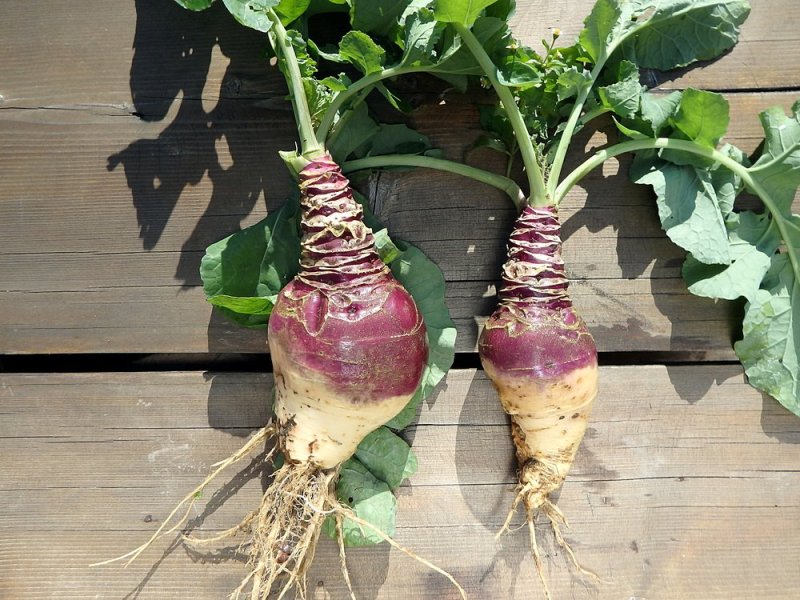Literally, the only thing I knew about rutabagas at the outset of this article is that it almost rhymes with Studebaker. Now I know that this winter root vegetable is the bastard child of a turnip and wild cabbage. I also found out that supertasters who think cilantro tastes like soap find this superfood too bitter to eat. Another interesting fact about this Brassica family member is that it can be carved like a pumpkin. Find out more about this nutritious cruciferous and what the heck to do with one below.
WTF Is a Rutabaga?

Rutabaga is a round root veg that is purple on top and yellow on the bottom. Inside, their flesh is a pale orange. Raw rutabagas have a sharp taste that is a bit milder than a turnip with a hint of cabbage. Although the crisp texture lends itself to parading around like a potato, rutabagas have more flavor than spuds, and are healthier, too. They have been described as Yukon Gold potatoes with a lot of attitude. Others have said that their sweet, peppery flavor is reminiscent of sweet radishes. Though still a bit bitter, they become buttery, sweet, and savory, taking on a creamier consistency when cooked. Also known as Swedish turnips, rutabagas are sweetish turnips and turnips can be substituted for them in a pinch.
Rutabaga Nutrition and Health Benefits

Rich in antioxidants, minerals, vitamins, and fiber, rutabaga has similar health benefits as its cruciferous cousins, broccoli and Brussels sprouts. One cup of rutabaga contains half your daily value of vitamin C. This low-calorie, low-carb veggie is also keto-friendly. One cup of boiled cubed rutabaga has 51 calories and 12 grams of carbs, while a cup of potatoes has 136 calories and 31 grams of carbs.
Bitterness

Though mildly bitter to most, rutabaga tastes twice as bitter to folks who have the “supertaster” genotype. In the words of Wikipedia, “As with watercress, mustard greens, turnip, broccoli, and horseradish, the human perception of bitterness in rutabaga is governed by a gene affecting the TAS2R bitter receptor, which detects the glucosinolates in rutabaga. Sensitive individuals with the genotype PAV/PAV (supertasters) find rutabaga twice as bitter as insensitive subjects (AVI/AVI). For the mixed type (PAV/AVI), the difference is not significant for rutabaga. As a result, sensitive individuals may find some rutabagas too bitter to eat.”
A Rutabaga by Any Other Name
Rutabaga comes from the Swedish dialectal word rotabagge, which means “root bunch,” but different countries call it different things. In Scotland, it’s called a neep, in Northern England, a snagger, and in many places, it is just called a turnip.
Trick-or-Treat

Rutabagas may have been the original jack-o’-lantern. In the Middle Ages, they were hollowed out to hold a burning lump of coal, which “guisers” would use as lanterns. Guiser means “A person in disguise.” According to American Foodie Abroad, “Guisers, who often played pranks, were youth who went house-to-house reciting verse in exchange for food.”
How to Pick a Rutabaga

While rutabagas are in season October through March, they peak in the dead of winter. When rooting around for rutabaga, choose one that feels heavy for its size with few marks or discolorations. It should be firm—softness signals that they are past their prime. Usually, they are sold without their stems, but if the stems are still attached, check them for signs of wilting.
Shelf Life
Unwashed, in a plastic bag, rutabagas keep in the fridge for up to a few weeks. Or they will last for up to 10 days if stored in a vegetable box.
How to Cook Rutabaga

Called a culinary underdog, this oft-overlooked vegetable is veritably versatile. Its structure holds up to all kinds of cooking techniques. At the risk of sounding like Bubba from Forrest Gump, rutabaga can be baked, boiled, braised, fried, grilled, mashed, pickled, puréed, roasted, sautéed, seared, sous vide, and steamed. But the options don’t stop there. Tender rutabagas can be eaten raw, too. Slice paper-thin with a mandoline and snack on raw rutabaga by itself or toss it into a salad with carrots, beets, turnips, or radishes. They are also stellar in soups and stews. Sub it for spuds—anything a potato can do, rutabaga can too. Spiralize it for a veggie-noodle moment. According to the New Yorker, rutabaga is “lower in starch than the usual vegetable-noodle suspects and is thus less prone to textural collapse.”
How to Peel a Rutabaga

Storebought rutabagas are often coated in paraffin wax to keep them from drying out, which can make them difficult to peel. But there’s more than one way to skin a rutabaga. Good Housekeeping suggests slicing “off the stem and root ends with a chef’s knife to create a stable base” then standing it up and removing the skin with a knife from top to bottom. My Recipes recommends tackling the exterior “after the vegetable has been cut in half and sliced.”
Rutabaga Recipes

In the South, rutabagas are simply steamed and served with melted butter. They also hold up well to the ceviche treatment, sliced thin and marinated in acid. Substitute rutabaga noodles for pasta in Cacio e Pepe. Mash it with sour cream, dill, salt, and pepper. Here are some more rutabaga recipes to try:
